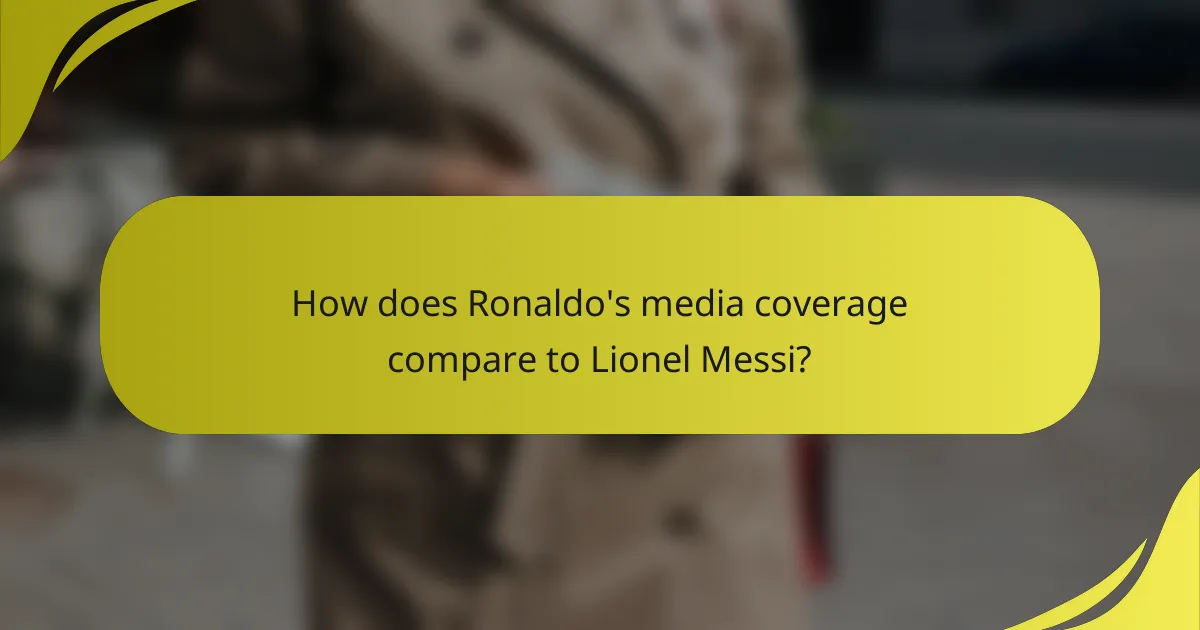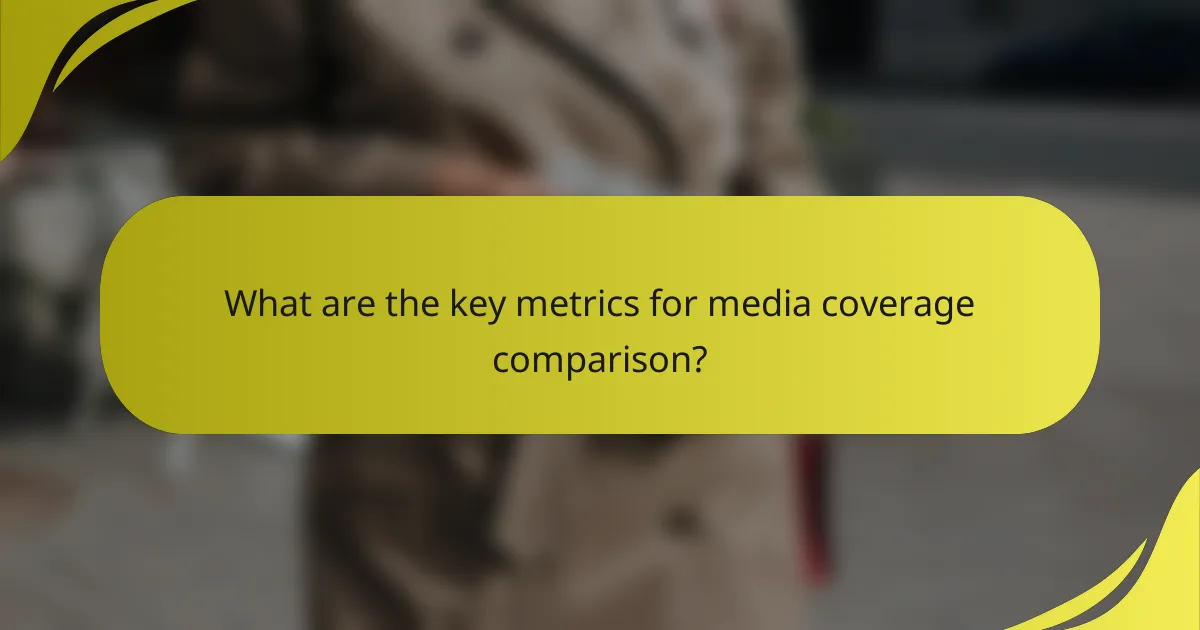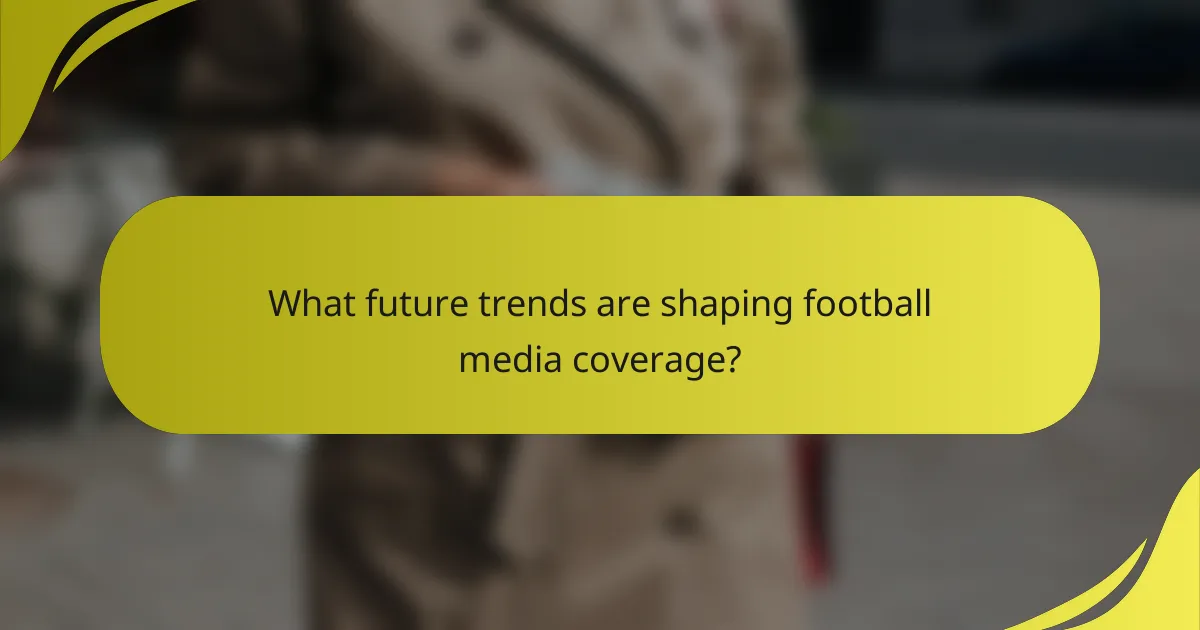The media coverage of football stars varies significantly, with Cristiano Ronaldo often receiving more attention than his peers, including Lionel Messi. This disparity is largely attributed to Ronaldo’s dynamic persona and extensive global brand, which captivates audiences, particularly in regions like the United States and Asia. By analyzing key metrics such as social media engagement and press article frequency, we can better understand the visibility and popularity of these athletes in the media landscape.

How does Ronaldo’s media coverage compare to Lionel Messi?
Ronaldo’s media coverage is often more extensive than Messi’s, driven by his larger-than-life persona and global brand. While both players receive significant attention, Ronaldo tends to dominate headlines, particularly in markets like the United States and Asia.
Ronaldo’s global media presence
Ronaldo’s global media presence is characterized by a vast social media following and frequent appearances in international news. His transfer to clubs in different countries has amplified his visibility, making him a household name across continents. Brands often leverage his image, contributing to a steady stream of coverage.
His engagement on platforms like Instagram, where he boasts millions of followers, allows him to connect directly with fans, further enhancing his media presence. This direct interaction often leads to more frequent news stories and updates about his life and career.
Messi’s media portrayal
Messi’s media portrayal is generally more reserved compared to Ronaldo’s flamboyant style. While he is celebrated for his incredible skills and achievements, the coverage tends to focus more on his performance on the pitch rather than his lifestyle. This results in a different type of media narrative that emphasizes humility and dedication.
Messi’s long-standing association with FC Barcelona also shaped his media image, creating a strong brand around loyalty and consistency. However, since his move to Paris Saint-Germain, there has been a noticeable increase in his media visibility, particularly in Europe.
Comparative analysis of coverage frequency
When comparing the frequency of coverage, Ronaldo often appears in more headlines than Messi. This can be attributed to his high-profile transfers, endorsements, and personal life events that attract media attention. Reports suggest that Ronaldo’s stories can dominate sports news cycles, especially during transfer windows.
In contrast, Messi’s coverage, while still significant, tends to peak during major tournaments or when he achieves notable milestones. This difference in coverage frequency highlights how personal branding and media strategies can influence public perception of athletes.

What are the key metrics for media coverage comparison?
Key metrics for comparing media coverage of football stars like Ronaldo include social media engagement, television viewership ratings, and press article frequency. These metrics help gauge the popularity and visibility of players in the media landscape.
Social media engagement statistics
Social media engagement statistics reflect how fans interact with football stars on platforms like Twitter, Instagram, and Facebook. Metrics such as likes, shares, comments, and followers provide insight into a player’s influence and reach. For instance, Ronaldo often leads in engagement, with millions of interactions per post, significantly outpacing other players.
To effectively compare social media engagement, consider the total number of followers and the average engagement rate, which can range from a few percent to over ten percent for top athletes. This helps identify not just popularity but also the active involvement of fans.
Television viewership ratings
Television viewership ratings indicate how many people watch matches featuring specific football stars. High-profile matches can attract millions of viewers, with ratings often measured in millions per game. For example, games featuring Ronaldo typically draw higher ratings compared to those with less prominent players.
When assessing viewership, look for peak ratings during significant tournaments or matches. Ratings can fluctuate based on the time of day, the importance of the match, and the competing programming, so context is crucial for accurate comparisons.
Press article frequency
Press article frequency measures how often football stars are mentioned in news articles and sports coverage. This metric can indicate a player’s media presence and public interest. Ronaldo frequently appears in headlines, often surpassing other stars in article counts, especially during transfer windows or after significant performances.
To evaluate press coverage, track the number of articles published over a specific period, such as a month or a season. Comparing these figures can reveal trends in media focus, with spikes often occurring around major events like World Cups or Champions League matches.

How do football stars influence media narratives?
Football stars significantly shape media narratives through their performances, personalities, and public personas. Their actions on and off the pitch often dictate the focus of sports journalism, influencing how stories are framed and discussed.
Ronaldo’s impact on sports journalism
Cristiano Ronaldo’s influence on sports journalism is profound, often driving headlines and discussions globally. His remarkable achievements, such as winning multiple Ballon d’Or awards, create a narrative of excellence that media outlets capitalize on, leading to extensive coverage.
Ronaldo’s presence on social media further amplifies his impact, as he engages millions of followers, shaping public perception and media angles. His ability to generate buzz around match performances or personal milestones often results in a surge of articles, interviews, and analyses.
Messi’s role in shaping football commentary
Lionel Messi plays a crucial role in shaping football commentary, often being the benchmark against which other players are measured. His unique playing style and consistent performance have led commentators to develop narratives that highlight his artistry and technical skill, influencing how matches are discussed.
Messi’s rivalry with Ronaldo has also created a dynamic in sports journalism, prompting debates and discussions that engage fans and analysts alike. This rivalry fuels a continuous cycle of media coverage, with each player’s achievements sparking comparisons and commentary that enrich the football narrative.

What are the trends in football media coverage?
Football media coverage is increasingly influenced by digital innovation and audience preferences. The rise of online platforms and personalized content is reshaping how fans engage with their favorite players and teams.
Emerging digital platforms
Digital platforms such as social media, streaming services, and dedicated sports apps are transforming football media coverage. These channels allow for real-time updates, highlights, and behind-the-scenes content, making it easier for fans to stay connected with their favorite players like Ronaldo.
Platforms like Instagram and TikTok have become essential for football stars to share their experiences and interact with fans directly. This shift not only enhances fan engagement but also allows players to control their narratives, often leading to increased visibility and sponsorship opportunities.
Shift towards personalized content
There is a growing trend towards personalized content in football media coverage, driven by data analytics and user preferences. Fans now expect tailored experiences, such as customized news feeds and targeted advertisements based on their interests and behaviors.
This shift means that media outlets must invest in technology to analyze viewer habits and preferences. For example, platforms may use algorithms to suggest articles, videos, or merchandise related to specific players or teams, enhancing the overall fan experience. However, it is crucial for media companies to balance personalization with privacy concerns to maintain trust with their audience.

How do geographical factors affect media coverage of Ronaldo?
Geographical factors significantly influence how media covers Cristiano Ronaldo compared to other football stars. Coverage varies based on regional interests, cultural connections, and local media landscapes, leading to distinct narratives and focus areas in different parts of the world.
Coverage in Europe vs. South America
In Europe, Ronaldo’s media coverage is extensive, often highlighting his performances in top leagues like the Premier League and La Liga. European outlets tend to focus on his club achievements, rivalries, and marketability, reflecting his status as a football icon.
Conversely, in South America, coverage may emphasize Ronaldo’s international career and his impact on global football. The narrative often intertwines with local football culture, showcasing how his success resonates with fans who admire his skill and dedication.
Regional fan engagement differences
Fan engagement varies greatly between Europe and South America, affecting how Ronaldo is portrayed in the media. In Europe, fans are more likely to engage with in-depth analyses, statistics, and tactical breakdowns of his performances.
In South America, engagement often leans towards emotional storytelling and personal anecdotes, connecting Ronaldo’s journey with local aspirations. This difference shapes the media’s focus, with European outlets prioritizing data-driven content and South American media favoring narrative-driven pieces.

What are the implications of media coverage on player branding?
Media coverage significantly shapes player branding by influencing public perception and marketability. High visibility in media can enhance a player’s image, leading to lucrative endorsements and partnerships.
Ronaldo’s brand partnerships
Cristiano Ronaldo has established a powerful brand through strategic partnerships with global companies. His collaborations include high-profile brands such as Nike, Herbalife, and CR7-branded products, which span clothing, fragrances, and hotels.
These partnerships not only boost his personal brand but also generate substantial revenue, often reaching hundreds of millions of dollars annually. Ronaldo’s social media presence further amplifies these partnerships, allowing him to engage directly with millions of fans.
Messi’s sponsorship deals
Lionel Messi, like Ronaldo, has a range of sponsorship deals that enhance his brand. His long-term partnership with Adidas is particularly notable, alongside collaborations with brands like Budweiser and Pepsi.
Messi’s deals are often characterized by their focus on authenticity and connection with fans, which resonates well in markets such as Europe and South America. His brand strategy emphasizes a more personal touch, often highlighting charitable initiatives and community involvement.

What future trends are shaping football media coverage?
Future trends in football media coverage are increasingly driven by technology and audience engagement. Key developments include the integration of artificial intelligence and the rise of interactive media experiences that enhance how fans consume content.
Increased use of AI in sports journalism
The integration of artificial intelligence in sports journalism is transforming how stories are reported and analyzed. AI tools can quickly process vast amounts of data, providing insights and generating content at speeds unattainable by human journalists.
For example, AI can analyze player performance statistics and generate match previews or post-match analyses, allowing media outlets to deliver timely and relevant content. However, reliance on AI should be balanced with human oversight to ensure accuracy and context in reporting.
Growth of interactive media experiences
Interactive media experiences are becoming a staple in football coverage, allowing fans to engage with content in innovative ways. Platforms now offer features such as live polls, augmented reality graphics, and real-time statistics that enhance the viewing experience.
These interactive elements not only keep audiences engaged but also provide deeper insights into games. Media outlets should consider incorporating these features to attract and retain viewers, especially younger audiences who prefer dynamic content over traditional formats.

